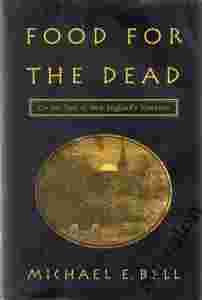|
Michael E. Bell
Food for Dead
On the Trail of New England's Vampires
New York 2001
Stron XIV+337, format: 16x24 cm
Książka wycofana z biblioteki: pieczątki na wewn. częściach okładki.
Stan niemal bardzo dobry
„I hated to admit, even to myself that I was excited by the prospect of interviewing Lewis Everett Peck; an Exeter, Rhode Island farmer and descendant of Mercy Brown whom I would soon discover probably was the last person exhumed as a vampire in America. I had been a folklorist for more than a decade and had hundreds of interviews under my belt but no one had ever told me a vampire story based on personal experience. Of course like most modern Americans I have a familiar, comfortable relationship with vampires. But these are fictional vampires. Their existence requires us to suspend our disbelief whether we're watching a movie reading a book or looking at an ad for beer or batteries. Everett was going to tell me about a vampire who actually existed—a kin relation no less—not some cardboard cutout, B-movie actor, or figment of an author's imagination.”
Has Michael E. Bell discovered the remnants of a ghoulish superstition, or a reasoned attempt to vanquish a terrible plague?
Close your eyes and imagine a vampire: Your mind's eye may conjure up Count Dracula with bared teeth and a shiny tuxedo. But; another kind of vampire was believed to live in rural New England long ago. Author and folklorist Michael E. Bell has spent twenty years pursuing this forgotten vampire tradition. His discoveries will surprise and enthrall skeptics, believ-ers; and all readers of this engaging book.
BelFs odyssey began in 1981 when Rhode Islander Everett Peck told him a family story passed down for generations. In 1892; months after young Mercy Brown succumbed to tuberculosis, her body was exhumed from a local graveyard. Relatives cut out her heart, burned it on a nearby rock7 and fed the ashes to her dying brother, hoping to cure him of the wasting disease. They feared that Mercy had become a vampire, sapping her sibling's vitality to provide sustenance for her own spectral existence. Or, had she become a scapegoat, blamed for the baffling affliction ravaging her family?
While such writers as Henry David Thoreau, H.P. Lovecraft and Amy Lowell drew on portions of this tradition in their writings, Bell captures the tale in its entirety for the first time. He takes readers on the road throughout New England, as he visits legend trippers and outright skeptics,
old cemeteries, and small town museums. With humor, insight, and sympathy, he uncovers story upon story of dying people who some believed were food for the dead—the source of life after death for their vampire kin. Bell introduces us to ordinary people confronted with an extraordinary illness that pre-modern medicine could neither explain nor cure.
Bell also makes comparisons to seemingly inexplicable forces in our own midst, like Ebola, mad cow, and AIDS, showing that while times have changed, our need for answers has not. He shows that our vampire-seeking ancestors battled disease with the most potent tools they possessed—an instinctual belief in their power to heal themselves, aided by their folk customs.
CONTENTS
ACKNOWLEDCMENTS IX PROLOCVE XI
CHAPTER 1 1
This Awful Thing
CHAPTER 2 18
Testing a Horrible Superstition
CHAPTER 3 39
Remarkable Happenings
CHAPTER 4 58
The Cause of Their Trouble Lay Before Them
CHAPTER 5 81
I Am Waiting and Watching for You
CHAPTER 6 109
I Thought For Sure They Were Coming After Me
CHAPTER 7 134
Don't Be a Rational Adult
CHAPTER 8 156
Never Strangers True Vampires Be
CHAPTER 9 178
Ghoulish, Wolfish Shapes
CHAPTER 10
The Unending River of Life
CHAPTER 11 226
Relicks of Many Old Customs
CHAPTER 12 252
A Ghoul in Every Deserted Fireplace
CHAPTER 13 279
Is That True of All Vampires?
CHAPTER 14 296
Food for the Dead
APPENDIX A 305
Chronology of Vampire Incidents in New England
APPENDIX B 305
Children of Stukeley and Honor Tillinghast
NOTES 306
WORKS SITED 323
INDEX 332
ABOUT THE AUTHOR 338
|

